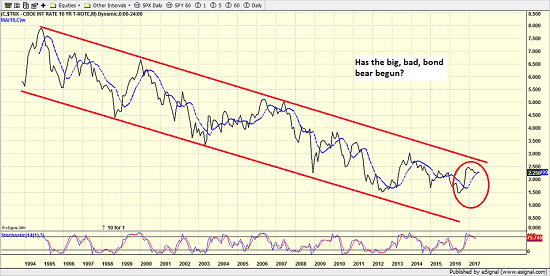Are You Prepared For The Big, Bad Bond Bear? (Should You Be?)
Most market analysts will concur that interest rates bottomed out in the summer of 2016. More specifically, after trending lower for approximately 35 years, the yield on the U.S. Gov’t 10-year Treasury Note hit an all-time low of 1.367% on July 5, 2016. And most every bond guru on the planet agrees that unless another global economic crisis hits, last summer’s low is unlikely to be exceeded any time soon.
Now consider the following: (1) U.S. economic growth is expected to continue to improve. (2) Inflation expectations have increased. (3) The Fed has embarked on a mission to normalize rates. (4) European economic growth is surprising to the upside. (5) The U.S. has reached “full employment.” And (6) the new administration’s policies (assuming they are implemented, of course) are expected to give the economy an extra boost. From a macro perspective, it is fairly easy to argue that this combination is bearish for bonds and as such, a big, bad bear market in bonds is likely waiting in the wings.
However, I think it is worth noting that this has been one of the most anticipated market events in history. Everywhere you turn, there is another article, webinar, or fund salesman touting what you need to do to avoid the coming calamity in bonds. And if you recall, this theme has been going strong since the “Taper Tantrum” of 2013 (when Ben Bernanke first started talking about backing off the Fed’s QE programs).
But so far at least, all the hand wringing and teeth gnashing over the big, bad bond bear has been, well… to borrow a line from William Shakespeare, “much ado about nothing.” In fact, the Barclays Aggregate Bond Index sports a cumulative gain of 11.12% since the end of 2013 (through 4/30/17). Thus, I might suggest that all the preparation for the bond debacle has been a bit premature, which, in my business, is another word for being wrong.
So, my first point on this fine Wednesday morning is that while everyone in the game has been busy preparing for the can’t-miss disaster in the bond market, it has actually been business as usual in the bond pits lately. Sure, rates bounced off the all-time lows as inflation and economic growth expectations increased last year. But, c’mon, what did you expect to see with the economy improving?
Long-Term Perspective
Take a look at the chart below. This is the yield of the U.S. 10-year Treasury Note over the last 23 years. As you can see, the trend has been moving from the upper left to the lower right for quite some time!
U.S. Gov’t 10-Year T-Note Yield – Monthly
(Click on image to enlarge)

What this chart doesn’t show is that rates have actually been in a downtrend since late 1981. And since bond prices rise when yields fall, it is plain to see that this has been a mega bull market.
What is being talked about here is a sea change of epic proportions for the bond market. I.E. a secular bull morphing into a secular bear. And since the last secular shift took place in 1981, folks are expecting this to be a pretty big deal.
The natural progression – and the general consensus in the financial community – is to expect rates to rise going forward. And since bond prices fall when rates rise, this is where all the angst about the big, bad bond bear originates. Never mind the fact that most of the folks shouting from the rooftops about this event have been singing the same song for nearly four years, this time it’s different!
Are You Prepared? (Should You Be?)
Given the simplicity of the macro logic (I.E. a stronger economy means higher inflation, which, in turn, means higher rates – rinse and repeat ad infinitum), it is easy to understand why nearly every fund company and ETF creator has developed products intended to protect investors from the inevitable rising rate environment. After all, given the magnitude of what is expected to transpire, Wall Street has assumed that everyone will need to rework their portfolios to protect themselves from the massive bond bear. Makes sense, right?
As you may have surmised by my hints of sarcasm above, there is a side of this story that many advisors and clients are probably not familiar with. For example, did you know that the bond market has been through this type of sea change before? Did you know that the U.S. has seen prolonged periods of rising rates in the past? And more importantly, do you know how the bond market reacted during these periods?
So, tomorrow we will look back at history and explore what type of downside we might expect to see from the much-ballyhooed disaster on the horizon for the bond market.
Thought For The Day:
Those at the top of the mountain didn’t just happen upon it.
Current Market Drivers
We strive to identify the driving forces behind the market action on a daily basis. The thinking is that if we can both identify and understand why stocks are doing what they are doing on a short-term basis; we are not likely to be surprised/blind-sided by a big move. Listed below are what we believe to be the driving forces of the current market (Listed in order of importance).
1. The State of Trump Administration Policies
2. The State of the U.S. Economy
3. The State of Earning Season
Disclosure: At the time of publication, Mr. Moenning and/or Sowell Management Services held long positions in the following securities mentioned: none. Note that positions may change at any ...
more


